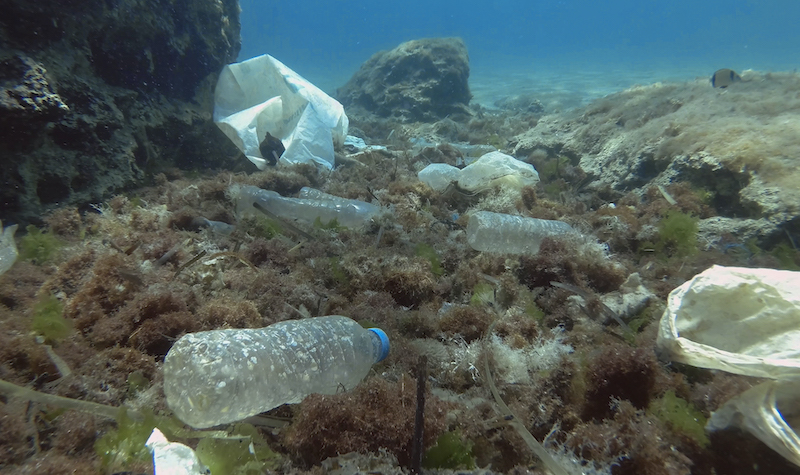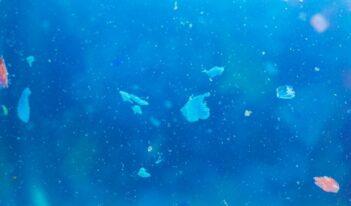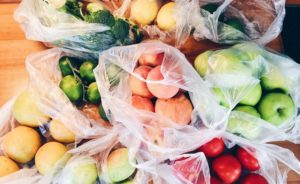
To save the seas from tiny plastics, a business leader proposes that plastics producers self-regulate.
Six miles underwater, at some of the deepest points of the oceans, crustaceans live in an other-worldly environment. Although unreachable by light, these crustaceans carry man-made plastics in their guts.
To address rising marine plastic pollution, philanthropist Andrew Forrest and a team of scientists last year proposed a voluntary industry initiative to encourage recycling plastic waste by making plastics production from fossil fuels more expensive. For simple and equitable administration, this initiative would only apply to manufacturers early in the plastics production chain. The initiative would also earmark some of the funds it raises to tackle plastic pollution challenges.
Each year, humans add about 17 billion pounds of plastic to the oceans. Marine plastic pollution runs the gamut from larger, visible items such as bottles to microplastics under 5 millimeters and even smaller nanoplastics under 1 micrometer—a thousandth of a millimeter. The Pacific Ocean now even features a giant garbage patch that environmentalists estimate covers about 620 thousand square miles, an area almost as large as Alaska.
Scholars estimate that global plastic pollution creates annually 2.2 trillion dollars of “environmental and social damage,” with the majority of this cost stemming from oceanic harm specifically.
For business leader and philanthropist Forrest, the biggest challenge in addressing these costs comes from their distributed nature. Rather than the plastics industry bearing the costs associated with their products, the costs fall upon a broad range of other parties worldwide.
For the plastics industry to assume these costs, Forrest proposes that manufacturers at the beginning of the plastics production chain pay a voluntary contribution to the initiative. These payments would facilitate the equitable distribution of a price premium across “the trillions of plastic items” consumers buy yearly and efforts to convert “plastic waste into a cashable commodity.”
Because a kilogram of plastics costs approximately one dollar, he recommends a contribution of 20 cents to 5 dollars per kilogram varying by the difficulty of processing the particular plastic involved. Using a takeout cup of coffee as an example, Forrest estimates that the price increase for end consumers would only be 1 to 3 cents. Funds raised would support “investment in transformative technologies” and “environmental remediation.”
Forrest suggests that the industry should designate an organization to administer the process of collecting the fees and directing a global audit system to monitor the distribution of revenues generated.
Forrest argues that this contribution could shift plastics production from an economy that burns or trashes most plastic waste to a circular economy that recycles most plastics. Because the contribution would increase the cost of new plastics production relative to the cost of recycling plastic waste, cost considerations would motivate plastics producers to demand more recycled plastics.
The subsequent increased demand could spark a virtuous cycle of new technologies emerging for better recycling plastics that then further lower the costs of recycled plastic, kicking off a new round of motivation for improving recycling technologies. In addition, Forrest suggests that the contribution would directly support developing renewable processes by funding investment in such technologies.
An industry-governed contribution bears several advantages over alternatives, such as international treaties or government taxes or regulations, Forrest argues. These advantages include ease of administration and uniformity, as industry-wide measures could prevent nations from developing conflicting regulatory approaches.
Although Forrest acknowledges the success of treaties such as the Montreal Protocol on Substances that Deplete the Ozone Layer, which addresses the narrower problem of chlorofluorocarbons, he claims that such treaties are less likely to succeed for plastic pollution. Plastics are more “pervasive and embedded in every part of the consumer economy,” he notes.
Domestic regulations and tax schemes present other challenges. Differences in laws and taxation between countries can create opportunities for companies to take advantage of a patchwork of regulatory regimes to produce plastics in the most accommodating jurisdictions.
Governments could impose border taxes. But given the enormous global trade in plastics, administering border taxation would require considerable effort from many governments to accurately assess and collect the resulting taxes.
Forrest argues that a single voluntary contribution program from plastics producers at the initial stage of plastics production would be simpler and operate more effectively than each country running its own tax on plastics in trade and at different stages of the manufacturing process. In addition, manufacturers would benefit from the reduced burden of complying with fewer regulatory regimes.
An industry-led initiative, however, need not close out the possibility of also having regulations such as treaties or taxes. Instead, Forrest’s voluntary contribution program could work alongside other policy tools, he says.
Various companies reportedly support Forrest’s proposal, including consumer-goods powerhouse Unilever and petroleum titan Saudi Aramco. In September 2020, Forrest announced a partnership between his Minderoo Foundation and the Indonesian government to begin piloting his voluntary tax initiative.
Cleaning such plastics from the ocean is not as simple as fishing a bag out. Nets to catch microplastics can also trap sea life. Even if cleanup were as simple as fishing for plastic, the sheer magnitude of waste already in the oceans hinders any cleanup efforts. The giant plastic patch in the Pacific alone contains an estimated 1.8 trillion individual plastic items together weighing over 176 million pounds. It continues to grow.
Larger plastic waste conjures familiar images of marine life ensnared in six-pack plastic rings. But microplastics and nanoplastics pose their own challenges and in ways that are both more insidious and difficult to cleanup than larger plastics are. Microplastics and nanoplastics result both from the breakdown of larger plastics and “directly from domestic and industrial sources.”
Nanoplastics threaten marine life by disrupting feeding behavior and reducing reproduction. These plastics eventually endanger human health as well when nanoplastics ingested by marine animals work their way “up food chains to human consumers.” Nanoplastics correlate with a long list of harmful health outcomes in humans, including cancer, obesity, and hormonal disorders. Children in particular face heightened risks from nanoplastics because of increased sensitivity to such materials.
Testing on deep-ocean crustaceans reveals that most of the plastics within them originated over 50 years ago, suggesting that the majority of plastic pollution has yet to finish harming marine life. Humanity should welcome comprehensive efforts—private or public—to mitigate this ticking time bomb, Forrest argues.



